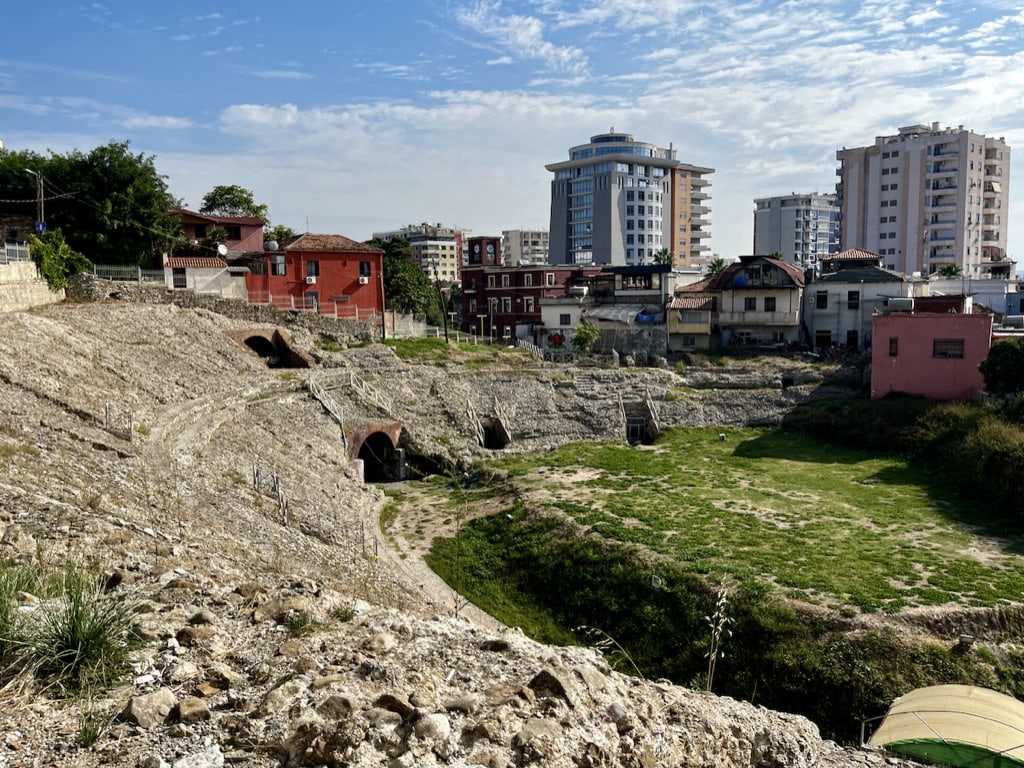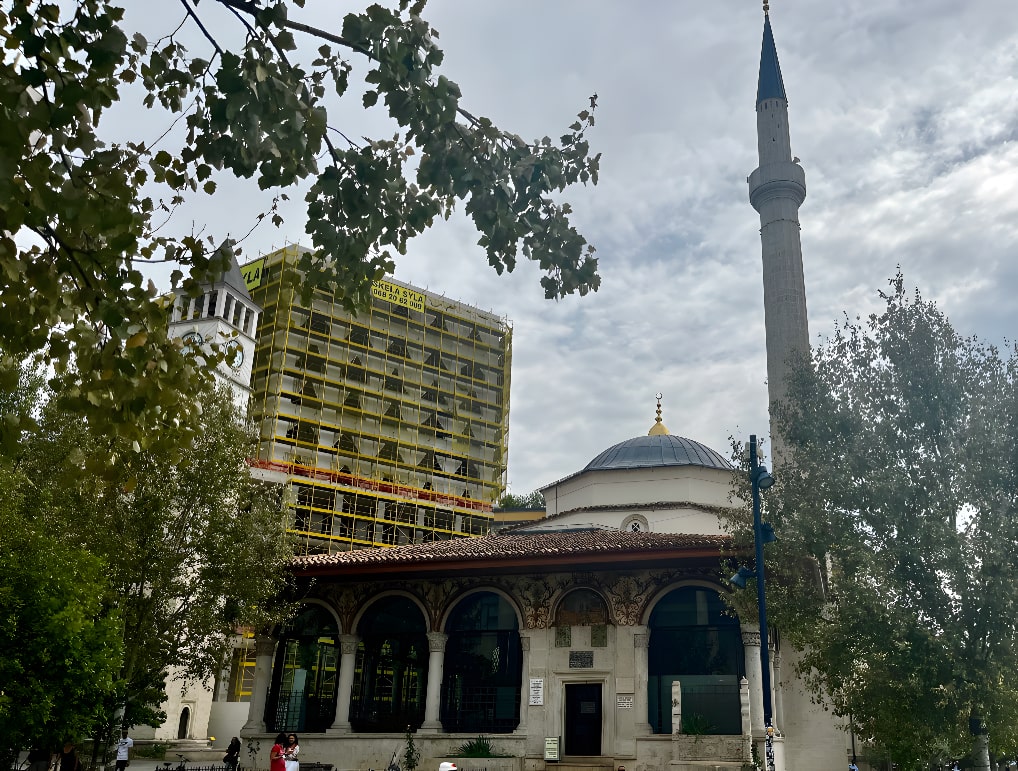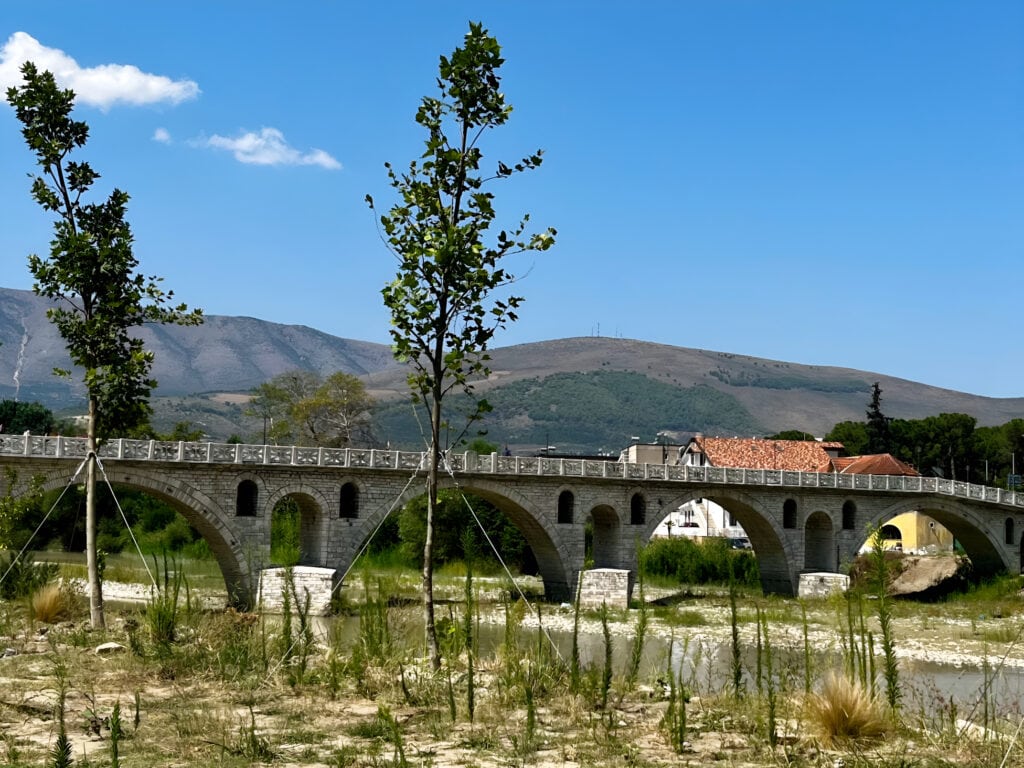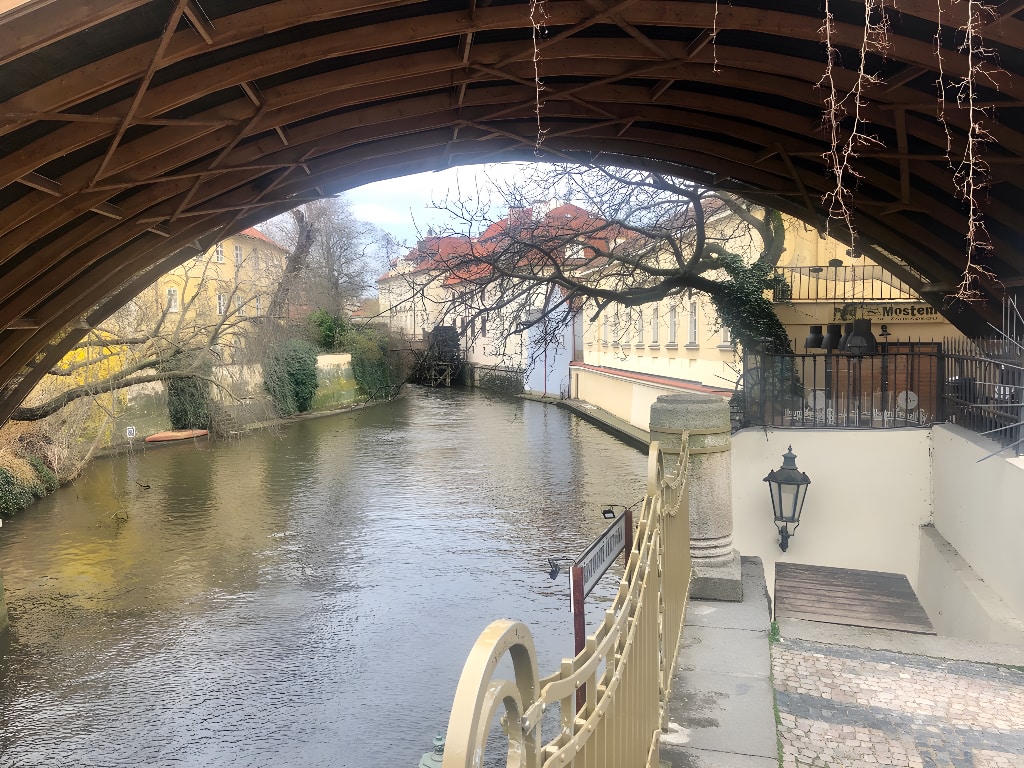Unforgettable 9-day road trip to Albania🇦🇱

In the spring of 2023, as the season for planning summer holidays approached, my teenage daughter suggested an unconventional destination.
Albania, must-visit country trending on Instagram.
It sounded interesting. I had never considered Albania before, but I love the idea of exploring places beyond the typical tourist circuit. A quick check of the distance from Prague and our available time revealed that reaching Ksamil is a stretch. But navigating the northern part of Albania seemed feasible. Decision made. My daughters and I embarked on a road trip to Albania. It was in August 2023.
Table of Contents
Practical insights:
The journey began with extensive map study and online research. Questions like the distance, the likelihood of driving on highways, and general expectations occupied my thoughts. Some outdated articles painted Albania as a “mafia” country, with car theft beyond the border. It is just so wrong. Albania is amazing and I can not wait to return next year.
- Mobile Data:
Unfortunately, Albania falls outside the “roam like at home” EU zone, a circumstance shared by other non-EU Balkan countries. For the most convenient access to mobile data, I recommend using Airalo.
Discovering Airalo has been a game-changer for me. If your phone supports e-SIM functionality, I highly recommend downloading it. This eliminates the hassle of constantly swapping physical SIM cards. Airalo allows you to effortlessly purchase e-SIM cards for nearly every country worldwide. Additionally, they offer regional SIM cards, such as for Europe or Africa. It truly works like magic.
- People:
Albanians are a very welcoming nation. As three women exploring the country, we felt at ease and comfortable throughout our journey. Although we fortunately didn’t require any special assistance, I felt that if we needed one, we would get instant help. There is no problem with English in cities and tourist areas. People try to assist and if they don’t speak English, they will get someone to translate.
- Cash-Centric Culture:
Albania remains predominantly cash-oriented. While larger establishments, restaurants, and petrol stations accept cards, it’s advisable to inquire beforehand about their card payment policies.
According to a World Bank report highlighted in the newspaper, Albania holds the lowest percentage globally of individuals aged 15 and above using digital payments. In 2021, this figure stood at a mere 35%.
- Currency:
The official currency is the Albanian LEK. The Euro is widely used in Albania, with a straightforward conversion of 100 LEK = 1 Euro. Euros are commonly accepted for various transactions, ranging from beach chair rentals to small parking fees and local shops. Accommodation expenses can also be settled in euros. Local ATMs provide a convenient option for cash withdrawal, but be mindful of withdrawal fees, which vary among banks. I recommended to explore multiple ATMs to assess withdrawal fees before deciding on the most economical option.
- Driving in Albania:
Albanian roads exhibit varying qualities, with some sections in good condition and others riddled with potholes. Vigilance is crucial, even on double-lane highways. During our summer visit, we noticed numerous vehicles with Italian, German, or UK registrations, sparking curiosity about the influx of foreign tourists. However, a simpler explanation unfolded: many of these vehicles were owned by Albanians residing abroad, returning for their summer holidays.
Petrol stations are nearby of each other and easy to drive. They, in the majority of the cases, accept card payments. It is recommended to inquire.
Driving a diesel SUV, I found myself contemplating the diesel options available at petrol stations, namely Blu diesel and Euro diesel. Opting for Euro diesel is recommended, as it aligns with the quality standards observed in the EU. Even if the price is slightly higher,
Day 1: Prague – Belgrade
Prague – Bratislava – Budapest – Belgrate: 895km on highways
Highway stamps:
Necessary for Czechia, Slovakia, and Hungary. Serbia has toll gates.
The stamps can be purchased online. Below are links for the official shops in each country.
– Czechia: https://edalnice.cz/en
– Slovak: https://eznamka.sk/en
– Hungarian: https://ematrica.nemzetiutdij.hu/en
Documents:
Ensure you have your car documents and Green card insurance ready for border crossing control. Also, arrange written consent for driving someone else’s car, even if it belongs to a family member who isn’t traveling with you.
We crossed all the borders during the trip with our Czech ID cards. We didn’t need passports at all. I still had them in my bag anyway, just in case.
Belgrade:
Arriving in Belgrade in the afternoon, we took the opportunity to explore the city center, enjoying its vibrant atmosphere with numerous restaurants and coffee shops.


Day 2: Belgrade – Durrës
Belgrade – Skopje – Pristina – Durrës: 770km. Mostly on highways except for the last approximately 100km in Albania.
What is the best route?
Planning the route proved slightly tricky as Google Maps suggested a shorter but less favorable route through Montenegro’s winding roads.
The quickest option was to drive from Belgrade to Skopje, and through Kosovo to Albania. When researching this option, I was getting some contradictory information. The questions I had in my head were: Is it safe to travel through Kosovo? Are going to spend a long time on the border post? Will we travel on highways? Are there any specific requirements to enter Kosovo?
Driving through Kosovo
Despite the complexities surrounding Kosovo’s status as a self-declared country, taking this route turned out to be the right choice.
We hit the highway in Belgrade and drove all the way towards Skopje. We continued and followed the direction of Pristina/Kosovo. Eventually, we got off the highway to follow the state road towards N.Macedonia/Kosovo border. Driving this road made me a little nervous. It was not in perfect condition. Luckily, it is only about 24km until you reach the border.
Note: the EU Green car insurance card is not valid in Kosovo. You need to pull off at the border post and buy insurance at a dedicated place. We bought one for 15 days for 30 euros.
We crossed into Kosovo without a major delay on the border. And what a pleasant surprise. A great new highway leads from the border to Pristina and the Albanian border.
While the border crossing into Albania was fast, the highway’s condition deteriorated. There is a double-line highway with a speed limit of 80km/h likely due to the less-than-ideal road conditions. But we made it all the way to Durrës.
Durrës check in
For me, one of the key considerations in planning a road trip is always PARKING. It turned out to be a critical factor in selecting accommodation in Durrës. Parking in Durrës during the peak season can be a daunting task, with cars seemingly filling every available space. This challenge is, I believe, due to the lack of underground garages in most apartment buildings and hotels.
To stay at the Wavebeachfront apartment was a perfect decision. With a limited number of private parking spaces, informing the owners in advance is essential, but their responsiveness and willingness to accommodate are truly amazing. Despite driving in and out of Durrës daily, they consistently ensured a parking spot for me, going the extra mile to assist with the somewhat tricky parking situation.
Choosing accommodation right along the beachfront promenade is ideal. You are steps away from the beach, ocean, and many restaurants, bars, and coffee shops. The walk on the promenade is super cool.
The beaches are filled with chairs and umbrellas which you have to rent. There are only a few beach areas where you can put your own towel down. Nevertheless, we enjoyed the comfort of the rented equipment.



Day 3: Exploring Durrës city
The city stands as one of the oldest in Albania. With a rich history, it even claimed the title of Albania’s capital in modern history. What makes Durrës special?
It is the history, beaches, and its role as a gateway to Western Europe; thanks to its strategic port location and proximity to the Italian coastline.
In my eyes, Durrës wears a dual identity. The city, nestled around the port, resonates with the daily life of the locals, revealing the heart and soul of Durrës. On the other hand, the “beach” part of the city atmosphere has evolved around the holidaymaker’s buzz.
About a 15-minute drive from our apartment brought us to Durrës city center. We headed to one of the watched, paid parking spaces. I am happy to pay the parking fee for the assurance that my car won’t be towed away by local authorities.
Our day began with a visit to Mulliri Vjeter coffee shop, the Albanian equivalent of “Starbucks.” This local coffee chain won us over with its unique interior design, inviting atmosphere, and, of course, excellent coffee, cakes, and sandwiches.
Walking around Durrës is easy allowing us to visit key points of interest
Durrës Amphitheater
The remains of a Roman Amphitheater dating back to the 2nd century AD. While the site might not meet high expectations due to its somewhat shabby condition, we enjoyed observing it from the outside without entering.
Durrës Castle
We strolled around the fortification walls and explored the Venetian tower. There is a nice city view from the top of the tower.
Sheshi Liria square
We walked around the main town square with many fountains. Surrounding the square, you’ll find an array of shops, offices, and restaurants.



Royal Villa of Durrës
For those willing to take a walk up the hills to the upper part of Durrës, the Royal Villa awaits. Once a summer residence for King Zog, we discovered that it was unfortunately closed, hidden behind imposing walls. However, the journey offered a rewarding ocean view.
Beach Promenade
The real highlight for us was the beach promenade. After reaching its end, we decided to have a light snack lunch in one of the promenade coffee shops while enjoying the ocean view.


Day 4: Tirana
Durrës – Tirana: 38km, about 1h via SH2 highway.
The journey from Durrës to Tirana is easy, with a continuous highway leading the way. However, be prepared, the traffic can get hecting upon entering Tirana. If your destination is the city center, a helpful tip is to stay in the middle lane. The right lane tends to be congested with stationary vehicles, while the left often designates a left-turn-only lane, leaving you reliant on someone in the middle lane to allow you in.
Parking in the city center:
Consider utilizing “Parking per Ju“, a convenient paid underground garage close to Skanderbeg Square, the heart of Tirana.
Places not to be missed
Skanderbeg Square:
Navigating Tirana’s city center on foot is straightforward, and like many tourists, our journey began at Skanderbeg Square. Covering a vast 40,000 square meters, the square’ is truly impressive.

Skanderbeg Statue
A monumental statue honoring the Albanian feudal lord and military commander who spearheaded the rebellion against the Ottoman Empire.
National Museum of history
Easily identifiable by its adorned mosaic, this building stands out on the square.
Et’hem Bey Mosque
Closed during the Albanian communist era, the mosque reopened in 1991. Adjacent to it is a clock tower.



Beyond Skanderbeg square
Europa Park
Positioned behind the Skanderbeg statue, this park symbolizes Albania’s aspirations to become an EU country.
A mere two minutes from Et’hem Bey Mosque, Bunk’art 2 awaits. This video museum exhibition is dedicated to the victims of communist terror.
Tirana Castle
It may not meet expectations of a castle; historically, it served as a fortress. Upon arrival, you’ll see remnants of ancient walls. Beyond these walls lies a vibrant area, filled with restaurants and shops.



Blloku
Blloku, once an exclusive district reserved for the Albanian dictator, Enver Hoxha, the party elite, and their families, stood sealed off by police and secret agents during the communist era. Nowadays it is one of Tirana’s trendiest and liveliest neighborhoods.
During our visit, we explored the Enver Hoxha house, now vacant. However, the latest news from October 2023 suggest plans to transform it into an art center, accessible to the public.
In close proximity to the former residence, another another interesting building not to be missed is the Pyramid of Tirana. Initially inaugurated in 1981 as a museum, it underwent various roles post-communism, serving as a conference center and a NATO base during the Kosovo war in 1999. Presently, following renovations, it operates as an IT center for Creative Technologies.


We concluded our visit to Tirana with a bit of shopping. There are plenty of small shops which sell brands and non-brands to explore. Also, Toptani Mall is conveniently located near Skanderbeg Square. We enjoyed a cup of coffee and spent time exploring some of our favorite retail brands that, unfortunately, aren’t available in Prague.
Day 5: Berat
Durrës to Berat: 90km, approx 1,5h
Easily accessible and ideal for a day excursion, Berat is often referred to as the “City of a Thousand Windows”. The journey took approximately 1.5 hours, with the first half cruising along the highway and the latter part weaving through the Albanian countryside on state roads. We chose to park at the Camper and Car Parking Hoxha which is conveniently located close to the town center.
Berat Castle
Prepare for a steep ascent if you choose to walk to the Berat castle area from the town center, particularly on a hot day like the one we experienced at 32°C at 10am. Alternatively, driving up to the castle is an option, exploring the area, and then returning to park in the city. Keep in mind that parking near the castle is limited.
With a history dating back to the 4th century BC, the Berat Castle is located on a stepped hill, offering beautiful views of the city below. We spent about 1.5 hours wandering through this ancient fortress, strolling along its walls, and exploring the various churches within its confines.



The city
Following our castle exploration, we descended to the town, crossing the river on the New Bridge and continuing our stroll towards the historic Gorica Bridge on the opposite side. As one of the oldest Ottoman bridges in Albania, the Gorica Bridge adds to Berat’s charm.



Before leaving town, we made sure not to miss Shtepia e Kafes Gimi. They offer delicious coffee, pancakes, and other treats. Note that during our visit, they accepted cash only.
After our coffee break, we embarked on the drive back to Durres, arriving in the middle of the afternoon, just in time to enjoy a bit of sun and the beach.
Day 6: Dhërmiu beach
Durrës to Dhërmiu Beach: 185km, 2 hours and 50 minutes
After exploring cities, we decided, it was time to enjoy a day on the beach. And we wanted to get to the Albanian Riviera, currently a trending destination. Albania’s coastline is divided by two seas—the Adriatic Sea in the north and the Ionian Sea, home to the Albanian Riviera.
Considering our time constraints during this trip, we could not make it all the way down to Ksamil, reserving that experience for our upcoming summer road trip in 2024.
We chose Dhërmiu beach, apparently one of the most beautiful ones on the Albanian Riviera.
How to get there
We took the SH4 Highway leading to Vlorë, often considered the starting point of the Albanian Riviera. At the onset of Vlorë, we transitioned onto the Vlorë bypass, navigating around the city and getting to a scenic route. Along this route, we pass by several spots perfect for pulling over and enjoying the view.
Eventually, we reached the LLogara pass, windy roads with very sharp turns to conquer. The road climbs up to over a thousand meters and reaches The Llogara National Park on the top. After reaching the highest point we started to descend, again on the windy road with sharp turns to reach our destination – Dhërmiu Beach.
Dhërmiu Beach
We found a parking spot in one of the local host-operated small paid parking areas. Luckily, we arrived fairly early as the parking spaces were taken quickly. After gathering our belongings, we walked down to the beach, reaching a beach promenade with various restaurants and bars. The beach itself is segmented into areas typically affiliated with individual restaurants. We chose a spot, that we liked and purchased our beach chair and umbrella. Unsurprisingly, the rental cost exceeded that of Durrës , totaling 20 euros. However, we were offered to enjoy an oversized bean bag complementing our two chairs and umbrella. Additionally, we were granted access to the restaurant’s facilities throughout the day.
The beach is covered with pebbles while the Durrës beach is sandy. The Ionic Sea is absolutely amazing—crystal blue, transparent, and pleasantly warm. What a perfect setup for a beach day while we still saw a lot from Albania during our drive.


Day 7: Shkodër
Durres to Shkodër: 106km, 3hours!
It looked like a good idea to make a day trip to Shkodër. It turned out to be a regrettable decision—one I hope others can learn from. The mistake, I made, was planning the trip in the evening when there was an “evening” traffic. So according to Google Maps, it should have taken us around 1,5 hours to get there. However, the reality was different. The road between Durrës and Shkodër proved to be one of the most congested ones. Our 106km drive, initiated at 8 am, unfolded into a terribly slow 3-hour journey due to persistent traffic.
This challenging start undoubtedly influenced our perception of Shkodër and its attractions.
Rozafa Castle
Our first destination was the Rozafa Castle, assumed as one of Albania’s significant fortresses. Parking at the castle is difficult. We managed to find a spot, but its legitimacy was questionable.
The expansive castle grounds offered beautiful views of Lake Shkodra and the entire city.



The city
After we explored the castle, we drove down to the city. To find parking seems to be mission impossible. We drove round and round and we eventually decided it might not be worth it anymore. Setting off for the road back to Durrës, we spotted a parking space and decided to take it. At last.
Exhausted, we walked to the city center and gratefully settled into the first coffee shop we found. After the much-needed break, we wandered around for a bit. We visited one of our favorite retailers to get the strength for our trip back.


The return journey mirrored our earlier struggles, prompting us to conclude that the experience was not worth it.
I guess, the lesson learned is to consider incorporating Shkodër into your entry or exit Albania plans. The city is very close to the border with the Montenegro. Ironically, the border post, we planned to drive through on our way back to Prague the next day.
Day 8: Durrës – Sukošan (returning from the road trip to Albania)
Via MonteNegro & Bosnia and Hercegovina. About 620km, 10hours
Time to commence our journey back as our available time prevented a longer stay. Contemplating the route, my primary concern revolved around potential delays at the border, particularly at the Serbia-Hungary checkpoint (entry to the Schengen zone), where we had seen an extensive queue. Eager to avoid queueing for too long, we opted for an alternative route through Montenegro. It meant driving through Shkodër.
Having learned the lessons from the previous day, we set out in the early morning hours to reach Shkodër without the bad traffic congestion. The strategy paid off, allowing us to proceed through Montenegro and Bosnia and Herzegovina. The drive through Bosnia and Hercegovina was on really windy scenic roads. Occasional lapses in mobile signal coverage made me hope our car would remain trouble-free. Although time constraints prevented us from exploring Bosnia and Herzegovina extensively, it has earned a place on our bucket list.
By late afternoon, we arrived in Sukošan, Croatia. Seizing the opportunity, we enjoyed some beach time before returning to our daily life in Prague.



Day 9: Sukošan – Prague
Sukošan – Zadar – Graz – Prague: 967km, approx. 11hours
The final stretch of our drive unfolded seamlessly, and we successfully returned to Prague. Our time in Albania was a delight, and without a doubt, we’re looking forward to returning.


